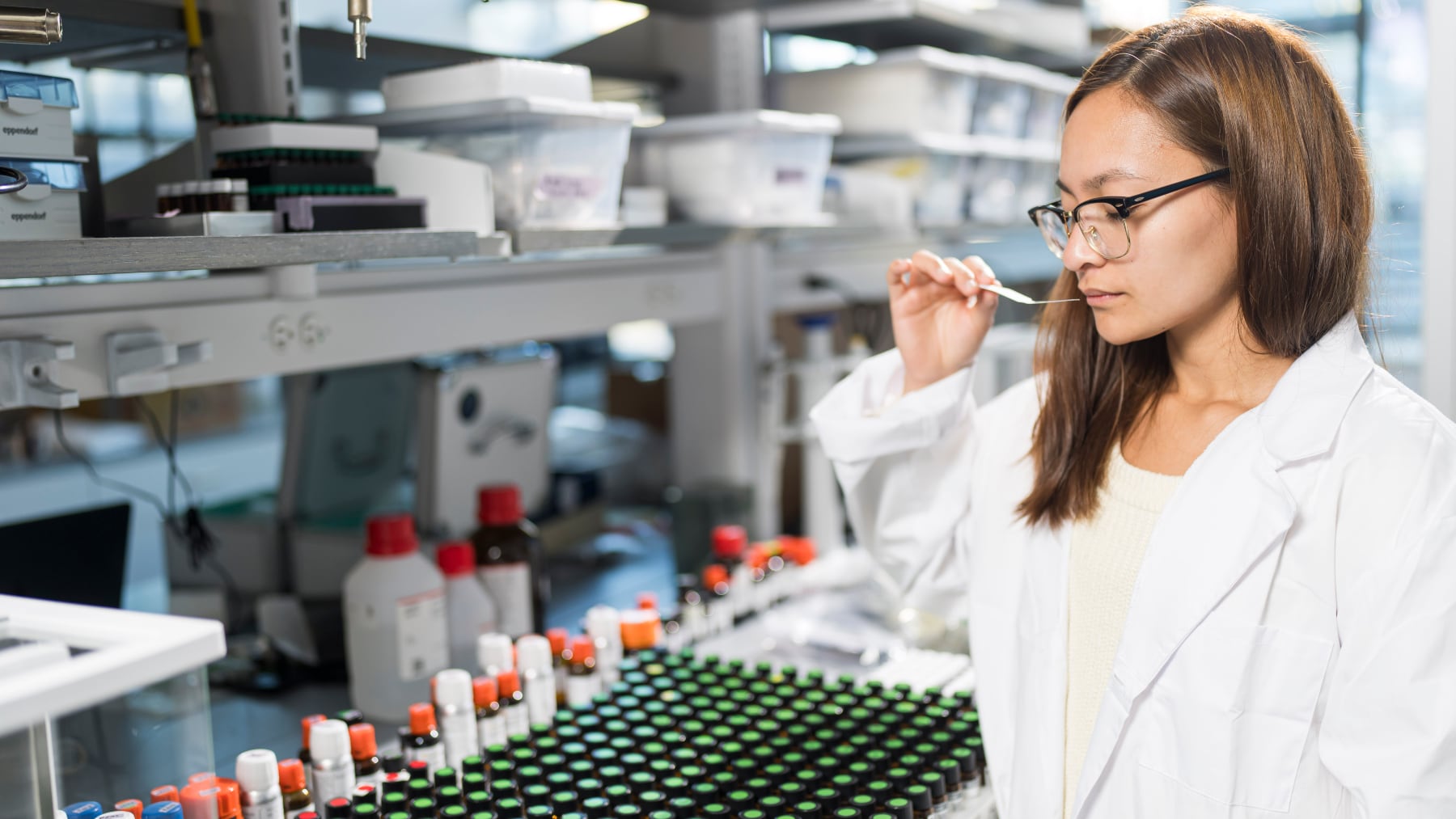
Molecule 4471A smells like something you’d detect in a perfume: It has a citrusy tang of sugar and acid, but also notes that turn it from fruit towards flowers.
It contains neither. Like other synthetic molecules created by Osmo, 4471A wasn’t derived from blooms blanketing a field in France but brewed in a lab — in this case, an office in New York packed with glass flasks, robotic machinery and jars of chemical compounds.
Osmo spun out from an AI research project at Google at the end of 2022. Founder and chief executive Alex Wiltschko had realised he could use a machine-learning technique called embedding, which underlies large language models like ChatGPT and Spotify’s personalisation algorithm, to effectively build a map of odour that allows the company to closely predict what a molecule will smell like from its structure.
“When we did all the engineering and worked it out, the map happened to be about 250-dimensional,” Wiltschko said. “That’s a map that needed to be learned with software, and so, in a sense, needed to wait for artificial intelligence.”
The first products containing Osmo-designed molecules are set to hit the market next year, according to Wiltschko. While the company can create never-before-smelled molecules, its business is in devising substitutes for ingredients that might be toxic or restricted. It could also help identify white spaces in the market and produce new scents to fill them.
Outside the world of human scent, it could potentially even find compounds that repel disease-transmitting insects like mosquitoes, an endeavour for which it received a $3.5 million grant from the Bill & Melinda Gates Foundation in November.
Those futuristic-sounding applications belie the fact that AI has quietly already become a fixture in the fast-growing fragrance industry, where Euromonitor projects sales will rise from $68.8 billion this year to nearly $80 billion by 2026. The start-up Moodify announced in October that P&G’s fragrance development group would begin using its AI software “for malodor control based on digital scent creation.” (P&G declined to comment.) Today, AI is also used for various tasks by large fragrance houses like Givaudan and International Flavors and Fragrances, which design many of the scents sold by brands from Lancôme to Brazil’s O Boticário.
“AI is present in our daily development, and honestly, it’s a large pillar of what we do,” said Johan Chaille de Nere, director of digital transformation at Givaudan, who added that the technology is there to support, rather than replace, perfumers.
Fragrance brands are using AI to better understand what shoppers want and help them formulate winning products, said Aishwarya Rajpara, a senior research analyst focused on beauty and health at Euromonitor. The technology allows perfumers to shorten the formulation process and find new ingredient combinations that can appeal to the growing audience of young shoppers searching for unique scents.
“Everyone wants to collect fragrances these days,” Rajpara said.
Making Sense of Scents
The human sense of smell is linked directly to the brain’s emotional centres and can be deeply subjective. That’s part of what makes scent difficult to digitise and make comprehensible to a machine, though it’s perhaps that same quality which makes AI especially useful in the formulation of new fragrances.
Givaudan, for instance, introduced an internal tool called Myrissi last year to help its perfumers anticipate the emotional reactions consumers will have to different scents. Part of what perfumers try to do when they create a new scent is to elicit an emotional response, but people have difficulty describing smells and their effects in words. Givaudan conducted nearly 30,000 consumer tests to learn what colours consumers associated with various scents and which emotions linked to those colours. They were able to use that data to build a model that lets their perfumers predict which emotions a fragrance will spark, according to Chaille de Nere.
IFF has taken its own approach to the same objective. In addition to interviewing subjects, it performed brain scans as they smelled fragrances to monitor their neurological responses. The scans generate huge amounts of data that can be turned into usable insights with AI, said Arnaud Montet, IFF’s vice president of human and consumer insights.
At IFF, the data scientists aren’t siloed in a separate department but work in the creative centre beside the perfumers so that the algorithms are developed “with perfumers and for perfumers,” Montet noted. The company also uses AI for jobs like monitoring consumer trends on social media around the world.
The aim is to get a better understanding of consumers and to support the perfumers in creating products that connect with them, so an IFF-designed scent like Polo Blue smells “blue” in the minds of shoppers, and Clinique’s Happy elicits happiness.
“It’s narrowing down the selection of ingredients in the palate they should be using in order to maximise the likelihood to be on target,” Montet said.
The new abilities offered by generative AI are attracting interest among fragrance companies as well. Chaille de Nere said Givaudan started researching years ago whether the same type of AI models that let users generate new imagery or music could be applied to fragrance. It has one tool it uses to propose new mixtures of fragrances, and he expects that in the next few years there will be even better AI models that the company will be able to adapt to its own purposes.
Osmo’s ambition is essentially to build the scent equivalent of the type of foundation model that powers tools such as ChatGPT.
“That’s the core engine of what it is that we’re building: a single model which understands what the world smells like, how to create new scents, how to modify scent, how to build scent at the molecular level upwards and how people will respond to them,” Wiltschko said.
The company is also at work on what he calls “scent teleportation,” which would allow someone to capture a scent in one location, digitise it entirely and then reproduce it later, like printing copies of a photograph.
Art Versus Science
Not everyone welcomes AI’s presence in perfumery. Some of the perfumers at IFF have been less willing to embrace AI than others, and attitudes don’t necessarily break down along generational lines.
Chandler Burr, former scent critic at The New York Times, author and founder of the department of olfactory art at New York’s Museum of Arts and Design, was openly sceptical of AI playing any creative role in fragrance. It might be useful for finding new ingredients, and perhaps minimally helpful in identifying fragrances that match an existing perfume, but not much beyond that, he argued.
Fragrance is an art, and “from that moment, the artist has to take over,” he said. “I don’t think that AI will ever be of significant help on the creative side.”
David Bontems, digital transformation director at IFF, stated that AI is merely a tool and that humans need to remain in creative control. Perfumers at a house like IFF generally create fragrances in response to a client brief. The technology is there to provide recommendations and guidance that can help them do their job better or more efficiently. But it’s still the human in charge of creation.
While a human touch will continue to be needed, Euromonitor’s Rajpara said AI’s role in fragrance is only set to grow. Givaudan’s Chaille de Nere echoed the sentiment.
“We have so many things to do in the fragrance industry with AI that I’m sure we are really at the beginning of a long journey,” he said. “The value of AI is significant today, but the value of AI in our ability to create better fragrances will be much higher in the future.”



